陈新仁《英语语言学实用教程》(第2版)笔记和课后习题详解-第1~4章【圣才出品】
陈新仁《英语语言学实用教程》章节题库(含名校考研真题)-第8~11章【圣才出品】

第8章英语语言的应用(I)I. Fill in the blanks.1. A perlocutionary act is the act performed by or resulting from saying something; it is the _____ of, or the _____the utterance. (人大2004研)【答案】consequence, change brought about by【解析】言外行为指说话的效果。
2. When a teacher says “The exam this year is going to be really difficult”, the sentence would have an _____force. (清华2001研,清华2000研)【答案】illocutionary【解析】言外行为,表达说话人的意图。
3. _____ were sentences that did not state a fact or describe a state, and were not verifiable.【答案】Performatives【解析】施为句是用来做事的,既不陈述事实,也不描述情况,且不能验证其真假。
II. Multiple Choices.1. The speech act theory was developed by _____.(对外经贸2006研)A. John SearleB. John AustinC. LevinsonD. G. Leech【答案】B【解析】言语行为理论是哲学家约翰·奥斯丁在他《如何以言行事》一文中提出的。
它从哲学意义上对语言交际的本质进行解释,其目的在于回答”用语言干什么”这个问题。
2. Point out which item does not fall under the same category as the rest. (Focus on the type of illocutionary act) (南京大学2007研)A. threatenB. adviseC. beseechD. urge【答案】A【解析】A为命令性言语行为,而其他三项为指示性言语行为。
陈新仁《英语语言学实用教程》(章节题库 第2章 英语语音)【圣才出品】

第2章英语语音Ⅰ.Fill in the following blanks:1.The sound/p/can be described with“_____,bilabial,stop”.(北二外2007研)【答案】voiceless【解析】/p/是双唇音,爆破音,清音。
2.The sound/b/can be described with“_____,bilabial,stop”.(北二外2004研)【答案】voiced【解析】/b/是双唇音,爆破音,浊音。
3.Consonant articulations are relatively easy to feel.And as a result are most conveniently described in terms of_____and manner of articulation.(北二外2004研)【答案】place【解析】辅音根据发音方式和发音部位进行分类。
4._____are produced by constricting or obstructing the vocal tract at some place to divert,impede,or completely shut off the flow of air in the oral cavity.(中山大学2006研)【答案】Consonants【解析】发音时,声道的某些部位受到压缩或阻碍后,使得气流在口腔里转向、受阻或完全被阻塞而产生的音叫做辅音。
5.The present system of the_____derives mainly from one developed in the1920s by the British phonetician,Daniel Jones(1881—1967),and his colleagues at University of London.(中山大学2008研)【答案】cardinal vowels【解析】基本元音是指一系列约定俗成、固定不变的元音特质,目的是为语言中实际存在的元音描述提供一个参照框架。
陈新仁《英语语言学实用教程》(章节题库第6章英语语言意义(Ⅰ))【圣才出品】
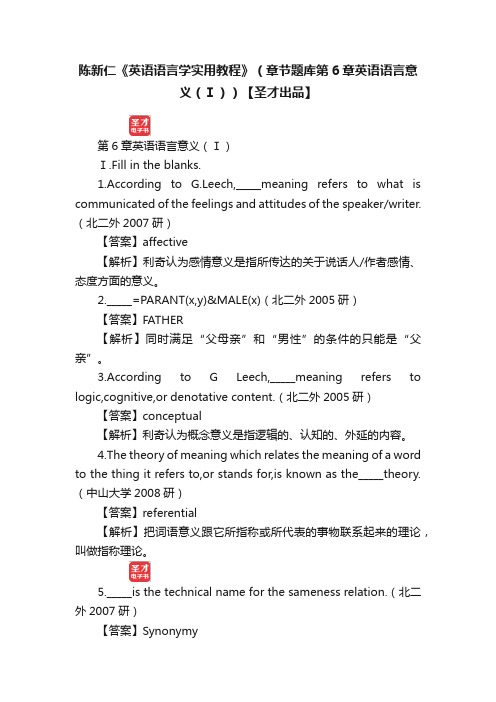
陈新仁《英语语言学实用教程》(章节题库第6章英语语言意义(Ⅰ))【圣才出品】第6章英语语言意义(Ⅰ)Ⅰ.Fill in the blanks.1.According to G.Leech,_____meaning refers to what is communicated of the feelings and attitudes of the speaker/writer.(北二外2007研)【答案】affective【解析】利奇认为感情意义是指所传达的关于说话人/作者感情、态度方面的意义。
2._____=PARANT(x,y)&MALE(x)(北二外2005研)【答案】FATHER【解析】同时满足“父母亲”和“男性”的条件的只能是“父亲”。
3.According to G Leech,_____meaning refers to logic,cognitive,or denotative content.(北二外2005研)【答案】conceptual【解析】利奇认为概念意义是指逻辑的、认知的、外延的内容。
4.The theory of meaning which relates the meaning of a word to the thing it refers to,or stands for,is known as the_____theory.(中山大学2008研)【答案】referential【解析】把词语意义跟它所指称或所代表的事物联系起来的理论,叫做指称理论。
5._____is the technical name for the sameness relation.(北二外2007研)【答案】Synonymy【解析】同义关系是相同关系的专业术语,完全的同义关系是很少的。
所谓的同义词都是依赖语境的,它们总是在这方面或那方面有所不同。
6.Terms like“apple”,“banana”and“pear”are_____of the term“fruit”.(北二外2007研)【答案】hyponyms【解析】上下义关系是指意义内包关系或者说一种类和成员间的关系。
陈新仁《英语语言学实用教程》配套题库【课后练习】(英语语音)【圣才出品】

第2章英语语音课后习题详解Check your understanding.State whether each of the following statements is True or False.(1) [i:] and [i] are allophones of the same phoneme.【答案】F(2) Not all English phonemes have allophones.【答案】T(3) The same set of vowels is used in all languages.【答案】F(4) All syllables must contain at least one vowel.【答案】F(5) The marking of word stress is arbitrary for the most part in English.【答案】F(6) English is a tone language.【答案】FIn-Class Activities1. In order to discover the phonemes used in the sound system of a language, scholars once designed a method based on the notion of minimal pairs, like “pat”vs. “fat”. Three requirements were proposed for identifying a minimal pair: (1) the two words are different in meaning; (2) the two words are different because of just one phoneme; and (3) the phonemes that make the two words different occur in the same phonetic environment. By phonetic environment we mean the sound(s) preceding and that/those following it, e. g. the phonetic environment of [I] in [pit] is [p_t] and that of [P] is [#_it] (#stands for a word or syllable boundary). The contrasting sounds in words forming a minimal pair are said to be in contrastive distribution, as in [bit] vs. [beit] and [pit] vs. [bit].Ask(1) What is the phonetic environment of [t] in [pit] ?Key: [i_](2) Are the following pairs of words minimal pairs?a. desk vs. task;b. leave vs. leakKey: a. No.b. Yes. ( li:v vs. li:k )2. Allophones as the realizations of the same phoneme are technically said to be in complementary distribution; in other words, they are found in different phonetic environments. For instance, the allophones of the phoneme /l/, clear [l] and dark [?], occur as follows:Clear [1]: occurs before vowels or after initial consonant(s) like /b/, /s/, /k/, //,/f/, /p/, /sp/.Dark [?]: occurs elsewhere.Ask(1) Characterize how the allophones of the phoneme/k/are complementarily distributed.Key: [k h ] in initial position; [k]after /s/; [k¬] in final position.(2) Is there any other way of characterizing the complementary distribution of clear [l] and dark [?]?Key: [l] before vowels; [ł] elsewhere.3. A phoneme can be further analyzed into a set of distinctive features. For example, /p/is defined as composed of such distinctive features as [plosive] + [bilabial] + [breathed] because each of them can distinguish/p/from some other phonemes. However, the property of aspiration contained in the allophone [P h] does not distinguish of meaning and therefore is not a distinctive feature in this case. Ask(1) What distinctive feature makes/f/and/v/different?Key: [voiced].(2) Can you specify the distinctive features for the following phonemes?a. /y/;b. /k/;c. /n/Key: a. /y/ [fricative] + [voiceless] + [palatal]b. /k/ [velar] + [voiceless] + [plosive]c. /n/ [nasal] + [voiced] + [alveolar]4. Suppose the distribution of [r] and [l] in the following words is characteristic of Korean: rupi; “ruby”; mul; “water”; kiri; “road”; pal; “leg”; saram; “person”; səul; “Seoul”; ratio; “radio”; ipalsa; “barber”(1) Are [r] and [l] in complementary distribution? In what environment does each occur?Key: Yes. [r] occurs before vowels; [l] occurs after vowels.(2) Do they occur in any minimal pairs?Key: No.(3) Suppose that [r] and [l] are allophones of one phoneme. State the rule that can derive the allophonic forms.Key: [r] is lateralized when it occurs after vowels.5. A sound may change by assimilating/copying a feature of a sequential/ neighboring sound; e. g. [] is realized as [], [] and [] respectively in “impossible”, “irresistible “, and “ illegal “ This is what we call the assimilation rule. Assimilation, particularly noticeable in ordinary conversational speech, occurs in a variety of contexts. For example, when you tell someone “I can go”, the influence of the following velar [] will almost certainly make the preceding nasal sound In [] come out as [] (a velar) rather than [] (an alveolar). Notice also that the vowel in “can” has also changed to schwa []from the isolated-word version [] through the process of weakening.Ask(1) Can you give more examples of assimilation?Key: compatriot, sing.(2) Can you find any exceptions?Key: input, unbeatable, Canberra.Now, study the following dialect of English carefully. There seems to be a predictable variant [] of the diphthong [].(3) What phonetic segments condition this change?Key: The consonant immediately after the vowel.6. If two sounds can occur in the same environment and the substitution of one sound for another does not cause a change of meaning, they are said to be in free variation. For example, “economics” can be read as both[] and []. Here, // and //are in free distribution.Ask:(1) Can you give more examples of free variation?Key: advertisement [əd΄və:tismənt] [əd΄və:tizmənt]; association [əsəusi΄eiʃən] [əsəu i΄eiən](2) Why do you think such a phenomenon exists in a language like English?Key: Individual variation is responsible for this phenomenon.7. A certain sound in words like “sign”, “design” and “resign” may be deleted even though it may be orthographically represented, while their corresponding nominal forms, namely “signature”, “designation” and “resignation”, involve the articulation of the sound. The process involved here is the deletion rule.Ask(1) Which sound is deleted in “sign”, “design” and “resign”?Key: [g](2) Can you offer other examples of deletion?Key: paradigm (atic), condemn(ation)(3) Can you give some words that involve total deletion?Key: plumb, plumber; climb, climbing(4) Are there any other types of deletion in English?Key: debt, know8. English has a number of expressions such as “chit-chat” and “flip-flop” which never seem to occur in the reverse order (i.e. chat-chit, flop-flip). Here are more。
陈新仁《英语语言学实用教程》(第2版)笔记和课后习题详解-第5~8章【圣才出品】

第5章英语语言结构(Ⅱ)5.1 复习笔记【本章要点】1. English paragraphs 英语段落2. English texts 英语语篇3. Cohesion in English texts 英语语篇的衔接4. Thematic progression in English texts 英语语篇主位推进【本章考点】英语段落,语篇的衔接等。
【本章内容索引】Ⅰ. English paragraphsⅡ. English textsⅢ.Cohesion in English texts1. Different means to develop cohesion in texts2. Classification of referenceⅣ. Thematic progression in English textsⅠ. English paragraphs(英语段落)A typical English paragraph employs a topic sentence stating the controlling idea of the paragraph.一个典型的英语段落中会用一个主题句来陈述整个段落的主旨大意。
To develop a paragraph, one may employ such means as exemplification, instantiation, comparison or contrast, cause effect reasoning, definition, analogy, and enumeration.为丰富段落,人们可能会用举例,例示,对比,因果推理,定义,类推和列举等。
Ⅱ. English texts(英语语篇)A well-written text is not a simple amalgam of paragraphs. It must be properly organized around a central purpose or coherent topic.一篇好的文章不是简单的段落叠加。
陈新仁《英语语言学实用教程》考研模拟试题及详解(一)【圣才出品】
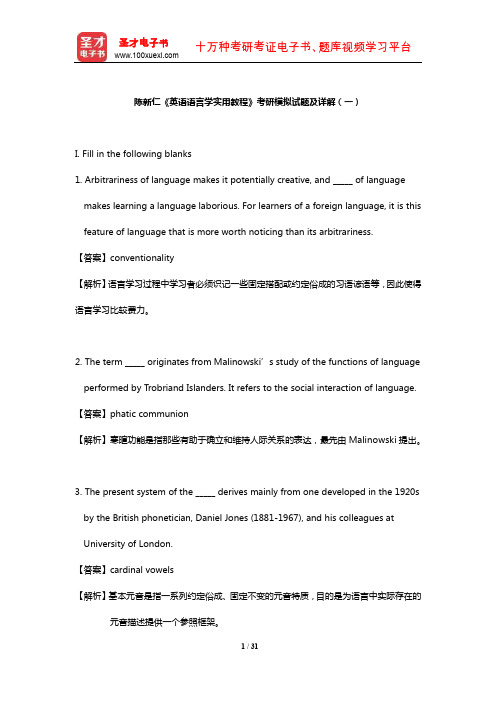
陈新仁《英语语言学实用教程》考研模拟试题及详解(一)I. Fill in the following blanks1. Arbitrariness of language makes it potentially creative, and _____ of language makes learning a language laborious. For learners of a foreign language, it is this feature of language that is more worth noticing than its arbitrariness.【答案】conventionality【解析】语言学习过程中学习者必须识记一些固定搭配或约定俗成的习语谚语等,因此使得语言学习比较费力。
2. The term _____ originates from Malinowski’s study of the functions of language performed by Trobriand Islanders. It refers to the social interaction of language. 【答案】phatic communion【解析】寒暄功能是指那些有助于确立和维持人际关系的表达,最先由Malinowski提出。
3. The present system of the _____ derives mainly from one developed in the 1920s by the British phonetician, Daniel Jones (1881-1967), and his colleagues at University of London.【答案】cardinal vowels【解析】基本元音是指一系列约定俗成、固定不变的元音特质,目的是为语言中实际存在的元音描述提供一个参照框架。
丁言仁《英语语言学纲要》笔记和课后习题详解-第1~4章【圣才出品】
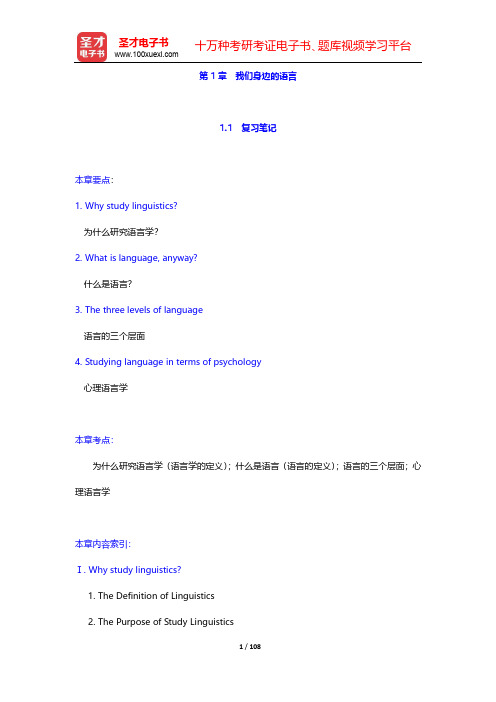
第1章我们身边的语言1.1 复习笔记本章要点:1. Why study linguistics?为什么研究语言学?2. What is language, anyway?什么是语言?3. The three levels of language语言的三个层面4. Studying language in terms of psychology心理语言学本章考点:为什么研究语言学(语言学的定义);什么是语言(语言的定义);语言的三个层面;心理语言学本章内容索引:Ⅰ. Why study linguistics?1. The Definition of Linguistics2. The Purpose of Study LinguisticsⅡ. What is language, anyway?1. The Definition of Language2. The Two Important Ways of Conceptualizing Language(1) Language as system(2) Language as activityⅢ. The three levels of language1. Meaning2. Wording3. SoundingⅣ. Studying language in terms of psychology1. Memory2. The ruleⅤ. SummaryⅠ. Why study linguistics? (为什么研究语言学)1. The Definition of Linguistics(语言学的定义)Linguistics, as any dictionary will tell us, is the scientific study of language.正如字典里告诉我们的一样,语言学就是语言的科学研究。
2. The Purpose of Study Linguistics(研究语言学的目的)Some knowledge of linguistics can be of great help in developing your ability to communicate in English. And the bonus is it does not need to be tedious either.在发展你的英语交流能力过程中,语言学知识能够给予你极大的帮助。
陈新仁《英语语言学实用教程》配套题库【课后练习】(英语语言单位)【圣才出品】

(2) Formulate a morphological rule regarding how to form the plural verb form from the singular verb form in Samoan.
Key: Positive terms can have negative morphemes added to them, as in “happy-unhappy”, but semantically negative ones rarely do, because unis deprecatory as well as negative.
Key: Duplicate the penultimate syllable.
2 / 24
圣才电子书 十万种考研考证电子书、题库视频学习平台
3. English has a couple of affixes that serve to express the opposition of meaning, of which un- figures prominently. Observe the following sets of English words (words marked with are not allowed in English):
Ask (1) Which other affixes are there in English that function as markers of negation?
陈新仁《英语语言学实用教程》(第2版)章节题库-英语语言单位【圣才出品】
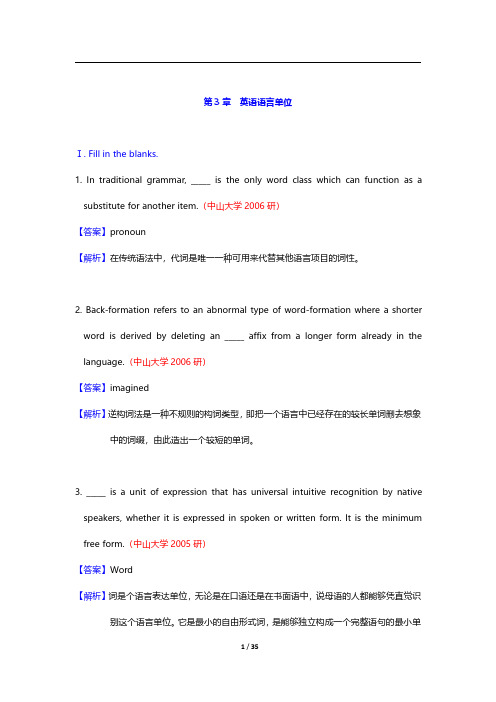
第3章英语语言单位Ⅰ.Fill in the blanks.1.In traditional grammar,_____is the only word class which can function as a substitute for another item.(中山大学2006研)【答案】pronoun【解析】在传统语法中,代词是唯一一种可用来代替其他语言项目的词性。
2.Back-formation refers to an abnormal type of word-formation where a shorter word is derived by deleting an_____affix from a longer form already in the language.(中山大学2006研)【答案】imagined【解析】逆构词法是一种不规则的构词类型,即把一个语言中已经存在的较长单词删去想象中的词缀,由此造出一个较短的单词。
3._____is a unit of expression that has universal intuitive recognition by native speakers,whether it is expressed in spoken or written form.It is the minimum free form.(中山大学2005研)【答案】Word【解析】词是个语言表达单位,无论是在口语还是在书面语中,说母语的人都能够凭直觉识别这个语言单位。
它是最小的自由形式词,是能够独立构成一个完整语句的最小单位。
4.Take is the_____of taking,taken and took.【答案】lexeme【解析】词位是语言词汇的基本单位,taking,taken和took都是take这个词位的词位变体。
5.The_____is the minimal distinctive unit in grammar,a unit which cannot be divided a unit which cannot be dividedwithout destroying or drastically altering the meaning,whether lexical or grammatical.(北二外2008研)【答案】morpheme【解析】语素是最小的语言单位,不能再进一步分成更小的单位而不破坏或彻底改变词汇意义或语法意义。
陈新仁《英语语言学实用教程》考研模拟试题及详解(二)【圣才出品】
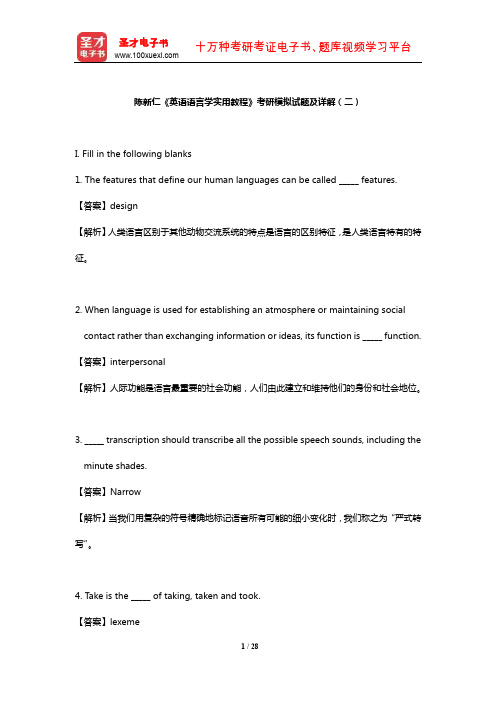
陈新仁《英语语言学实用教程》考研模拟试题及详解(二)I. Fill in the following blanks1. The features that define our human languages can be called _____ features.【答案】design【解析】人类语言区别于其他动物交流系统的特点是语言的区别特征,是人类语言特有的特征。
2. When language is used for establishing an atmosphere or maintaining social contact rather than exchanging information or ideas, its function is _____ function. 【答案】interpersonal【解析】人际功能是语言最重要的社会功能,人们由此建立和维持他们的身份和社会地位。
3. _____ transcription should transcribe all the possible speech sounds, including the minute shades.【答案】Narrow【解析】当我们用复杂的符号精确地标记语音所有可能的细小变化时,我们称之为“严式转写”。
4. Take is the _____ of taking, taken and took.【答案】lexeme【解析】词位是语言词汇的基本单位,taking, taken 和took都是take这个词位的词位变体。
5. An _____ is pronounced letter by letter, while an _____ is pronounced as a word. 【答案】initialism; acronym【解析】首字母缩写和缩略词的区别在于,前者是一个一个字母读,后者是按单词读。
陈新仁《英语语言学实用教程》配套题库【课后练习】(英语语言的应用(II))【圣才出品】
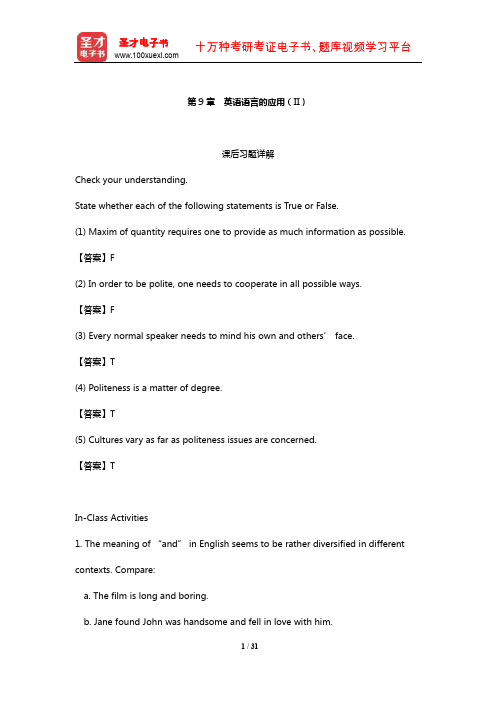
第9章英语语言的应用(II)课后习题详解Check your understanding.State whether each of the following statements is True or False.(1) Maxim of quantity requires one to provide as much information as possible. 【答案】F(2) In order to be polite, one needs to cooperate in all possible ways.【答案】F(3) Every normal speaker needs to mind his own and others’ face.【答案】T(4) Politeness is a matter of degree.【答案】T(5) Cultures vary as far as politeness issues are concerned.【答案】TIn-Class Activities1. The meaning of “and” in English seems to be rather diversified in different contexts. Compare:a. The film is long and boring.b. Jane found John was handsome and fell in love with him.c. Jane called John and told him the news.Ask(1) How would you interpret “and” in each of the cases?Key: In a, “and” is a pure conjunction that coordinates two parts. In b, “and”signals cause-effect relation. In c, “and” indicates the sequence of events, meaning “and then”.(2) Do you vote for the argument that “and” is polysemous, or the argument that“and” has just one basic meaning and the other “meanings” areimplicatures derived from the context?Now, focus on the use of “or” in English:d. His birthday is in June or July.e. For the new post, a diploma in mathematics or computer science is a must.Key: “and” has one basic meaning. Other interpretations are derived from this basic meaning plus contextual information by way of implicature.(3) It seems that “or” has two conflicting meanings. What are they? Do you thinkone meaning is basic and the other is derivable in context by virtue ofimplicature?Key: They are exclusive “or” and inclusive “or”. The inclusive “or” is more basic. The exclusive “or” is realized by way of implicature.2. Being underinformative or overinformative in daily conversation is not rare. When either happens, some implicature is intended. Look at the followingfragment of talk:Jane: What’s your stepmother like?John: She’s a woman and she married my father.Ask(1) What does John want to say in actuality?Key: The stepmother is no good.(2) Why does John answer that way, you suppose?Now consider the following:Jane: When did you come back last night?John: Two o’clock in the morning. The meeting was just too long.Key: He does not want to say directly that his stepmother is bad.(3) What does John imply in the second part of his reply?Key: He did not mean to be late.(4) Why does John give that additional information?Public signs and ads also employ additional information sometimes. Look at the following pictures:Key: He wants to explain why he was late so that Jane would pardon him, if she minded.(5) What is the extra information in each of the cases?Key: In the first picture, the additional information is that “there is ice falling”.In the second picture, the additional information is “Heart disease is the#1 killer of African Americans”. In the third picture, the additionalinformation is “水是生命的源泉。
陈新仁《英语语言学实用教程》章节题库(含名校考研真题)-第1~3章【圣才出品】

第1章导言I. Fill in the following blanks:1. Arbitrariness of language makes it potentially creative, and _____ of language makes learning a language laborious. For learners of a foreign language, it is this feature of language that is more worth noticing than its arbitrariness.(大连外国语学院2008研)【答案】conventionality【解析】语言学习过程中学习者必须识记一些固定搭配或约定俗成的习语谚语等,因此使得语言学习比较费力。
2. In Sau ssure’s view, the relationship between signifier(sound image) and signified (concept) is _____.(北二外2005研)【答案】arbitrary【解析】索绪尔认为符号的形式或声音与其意义之间没有逻辑联系,所以两者之间的关系是任意的。
3. Human language is arbitrary. This refers to the fact that there is no logical or intrinsic connection between a particular sound and the _____it is associated with.(人大2007研)【答案】meaning【解析】索绪尔认为符号的形式或声音与其意义之间没有逻辑联系,所以两者之间的关系是任意的。
4. The features that define our human languages can be called _____ features.(北二外2006研)【答案】design【解析】人类语言区别于其他动物交流系统的特点是语言的区别特征,是人类语言特有的特征。
陈新仁《英语语言学实用教程》(第2版)配套题库-章节题库-第1~3章【圣才出品】

第二部分章节题库第1章导言Ⅰ. Fill in the following blanks:1. Arbitrariness of language makes it potentially creative, and _____ of language makes learning a language laborious. For learners of a foreign language, it is this feature of language that is more worth noticing than its arbitrariness.(大连外国语学院2008研)【答案】conventionality【解析】语言学习过程中学习者必须识记一些固定搭配或约定俗成的习语谚语等,因此使得语言学习比较费力。
2. In Saussure’s view, the relationship between signifier(sound image) and signified (concept) is _____.(北二外2005研)【答案】arbitrary【解析】索绪尔认为符号的形式或声音与其意义之间没有逻辑联系,所以两者之间的关系是任意的。
3. The term _____ originates from Malinowski’s study of the functions of language performed by Trobriand Islanders. It refers to the social interaction of language.(中山大学2006研)【答案】phatic communion【解析】寒暄功能是指那些有助于确立和维持人际关系的表达,最先由Malinowski提出。
4. The features that define our human languages can be called _____ features.(北二外2006研)【答案】design【解析】人类语言区别于其他动物交流系统的特点是语言的区别特征,是人类语言特有的特征。
- 1、下载文档前请自行甄别文档内容的完整性,平台不提供额外的编辑、内容补充、找答案等附加服务。
- 2、"仅部分预览"的文档,不可在线预览部分如存在完整性等问题,可反馈申请退款(可完整预览的文档不适用该条件!)。
- 3、如文档侵犯您的权益,请联系客服反馈,我们会尽快为您处理(人工客服工作时间:9:00-18:30)。
第1章导言1.1 复习笔记【本章要点】1. The functions of language 语言的功能2. The defining features of language 语言的区别性特征3. The origin of language 语言的起源4. The acquisition of language 语言的习得【本章考点】语言的功能,语言的起源,语言的区别性特征及语言习得等。
【本章内容索引】Ⅰ. The languages of the worldⅡ. The functions of language1. Phatic2. Directive3. Informative4. Interrogative5. Expressive/Emotive6. Evocative7. Performative8. Recreational9. MetalinguisticⅢ. The defining features of language1. Arbitrariness2. Duality3. Creativity4. Displacement5. Cultural TransmissionⅣ. The origin of language1. The bow-wow theory2. The pooh-pooh theory3. The ding-dong theory4. The yo-he-ho theory5. The ta-ta theory6. The ta-ra-ra-boom-de-ay theory Ⅴ. The acquisition of language1. Features of language acquisition2. Stages of language acquisition Ⅵ. Linguistics: The science of language1. Definition2. Branch3. CharacterⅠ. The languages of the world(世界上的语言)There are some 6, 800 known languages spoken in 200 countries of the world. 世界上共有6800多种语言,被200多个国家的人们所使用。
There are over 100 language families in the world.世界上共有一百多个语系。
Ⅱ. The functions of language(语言的功能)1. Phatic: Hello.寒暄功能。
例:你好。
2. Directive: Get out of my way.指令功能。
例:滚开!3. Informative: The earth revolves around the sun.信息功能。
例:地球围着太阳转。
4. Interrogative: Do you know his hobby?询问功能。
例:你知道他的爱好吗?5. Expressive/Emotive: I hate her.表达功能。
例:我讨厌她。
6. Evocative: How do you like Jack?感情功能。
例:你觉得杰克怎么样?7. Performative: I hereby declare the meeting open.施为功能。
例:我特此宣布会议开始。
8. Recreational: Funny jokes make people laugh.娱乐功能。
例:有趣的笑话使人发笑。
9. Metalinguistic:Use language to explain language itself.元语言功能。
例:用语言谈论语言本身。
Ⅲ. The defining features of language(语言的区别性特征)1. Arbitrariness(任意性)As a symbolic unit, a word has both form and meaning. As a rule, the relation between the form and the meaning, however, is arbitrary. In other words, there is no inherent connection between the form and the meaning.作为象征性符号,单词拥有形式和意义。
然而,通常形式和意义之间的关系是任意的,换言之,二者之间没有内在联系。
2. Duality(二重性)Language operates at two levels: at the lower level, language consists of a bunch of meaningless elements; at the higher level, the meaningless elements combine to form meaningful units like words.二重性是指语言拥有两层结构的属性,在底层结构,语言含有一系列无意义的音素;在上层结构,这些无意义的符号组成有意义的单位,如单词等。
3. Creativity(创造性)“Creativity”, sometimes also called “productivity”, means the property which makes possible the construction and interpretation of new symbols, i.e. of signalsthat have not been previously encountered.创造性指语言的能产性,它能够使人造出和理解许多新符号,其中很多是以前从未听过的。
4. Displacement(移位性)Language can be used to talk about what happened in the past, what is happening at present, or what will happen in the future. Also, we can use language to refer to things no matter how far away they are or whether they are present or absent.移位性是指人类语言可以让使用者在交际时用语言符号代表时间上和空间上并不可及的物体、事件和观点,超越过去、现在和将来。
5. Cultural transmission(文化传递性)Language is not genetically inherited. Passed from generation to generation, it requires some learning.语言不是靠遗传,而是通过学习代代相传的。
Natural languages have a lot in common. The common properties that all natural languages share are termed “universals”. Here are some of them: 自然语言有很多共同之处。
所有自然语言共有的共同属性被称为“普遍性”。
以下是其中一些:(1) Wherever humans exist, language exists.(2) The vocabulary of any language can be expanded to include new words for new concepts.(3) All languages change through time.(4) All grammars contain rules for the formation of words and sentences of a similar kind.(5) Similar grammatical categories (for example, nouns, verbs) are found in all languages.(1)哪里有人类,哪里就有语言。
(2)任何语言的词汇量都可以扩充,包括新概念的新词汇。
(3)所有的语言都是随着时间而变化的。
(4)所有的语法都包含类似的单词和句子的构成规则。
(5)所有语言都有相似的语法范畴(如名词、动词)。
Ⅳ. The origin of language(语言的起源)1. The bow-wow theory(“汪汪”理论)Primitive words were imitative of sounds; for example, from the barking of dogs, we created a word which meant “dog”or “bark”.语言是模仿自然的声音,例如动物的叫声,狗叫声等。
2. The pooh-pooh theory(“噗噗”理论)Language is derived from instinctive cries called forth by intense emotions.语言来源于人本能的情感声音,表达疼痛等。
3.The ding-dong theory(“叮咚”理论)Every substance has a natural resonance when struck. Possibly, when man was struck by an impression (for example, the sight of a sheep), he would emit the appropriate vocal response, that is, the word “sheep”.。
